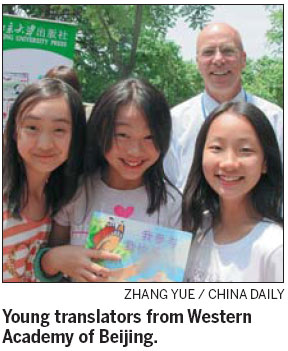
A group of children in Beijing has translated a series of picture books, originally by four Spanish painters and writers, from English to Chinese.
This is the first series of children's literature translated by international students whose first language is not Chinese, according to Wang Biao, a senior editor from the Department of Chinese Language and Linguistics of Peking University Press, who is in charge of the publication.
"Our target readers are those children who are learning Chinese both in China and overseas," Wang says of the book series recently published by Peking University Press.
The 17 children who participated in the translation are mostly overseas-born Chinese and fifth grade students from Western Academy of Beijing, the city's second largest international school.
The books the students translated are divided into themes, such as On My Way to School, illustrated by Spanish painter Subi and written by Anna Obiols; and Adventure Into the Forest, by Josep Maria Cardona and Cristina Falcon Maldonado.
The books tell stories about children's lives and their adventures in various countries, such as the United States, India, Japan and Senegal.
"By describing children's daily lives in different countries these books give a simple and vivid introduction to the cultural and historical features of the four countries," Wang says.
Wang says the books have already been translated into English, Spanish, Portuguese and Catalan.

There are 12 books in the series, but Wang explains the children translated just eight because four are mainly related to fine arts, which they were not so familiar with.
These four books introduce painters, such as Claude Monet and Vincent van Gogh, and were translated in-house.
The book On My Way to School describes how Patrick, a boy in the United States, starts his day. He is woken by his dog, and has cereal, milk, bread and butter for breakfast. He rides on his skateboard to catch the school bus and almost runs over a lady walking with a cup of coffee in her hand, a common but also symbolic daily routine for people in the US.
"In the beginning, we thought it was really easy, but when we actually started translating, it was not as easy as we thought," says Lau Tin Sun, who participated in the translation.
"English has a completely different grammar compared to Chinese. Therefore, it took us quite a lot of time and energy to change the grammar. But it was truly amazing to see the books in print. Publishing books during primary school, this is really a good memory."
At the end of each book, there is a brief introduction about the history and geographic features of the country where the story takes place.
"Almost all the 17 kids come from a bilingual family, thus they have a good mastery of both the Chinese and English languages," says Deng Xiaoxia from the Peking University Press, who helped with publication.
The kids' translation is "amazing", as the words they choose are "childish but interesting" and appeal to young readers - compared to the words used by professional translators, Deng says.
Geoffrey Andrews, principal of Western Academy of Beijing, has been working in China for about a year. He started reading the books by his students in June.
"I was amazed by how creative their imagination can be, and the stories are truly lively," the American says. "We have been making continuous efforts to guide the students from practical language skills, and this time their work truly amazed me."
The Chinese versions of the books will be available to readers in Europe and the US later this year.
zhangyue@chinadaily.com.cn